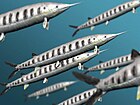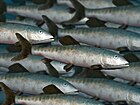Dorsetichthys
| Dorsetichthys Temporal range:
| |
|---|---|

| |
| Fossil of Dorsetichthys bechei | |
| Scientific classification | |
| Kingdom: | Animalia |
| Phylum: | Chordata |
| Class: | Actinopterygii |
| Infraclass: | Teleostei |
| Order: | †Dorsetichthyiformes Arratia, 2013 |
| Family: | †Dorsetichthyidae Arratia, 2013 |
| Genus: | †Dorsetichthys Arratia, 2013 |
| Species: | †D. bechei
|
| Binomial name | |
| †Dorsetichthys bechei (Agassiz, 1837)
| |
Dorsetichthys is an extinct genus of stem-teleost ray-finned fish from the Early Jurassic period of Europe.
Description[]
Dorsetichthys was a herring-like fish about 40 centimetres (16 in) long, although it was not closely related to modern herring. Like them, however, it had a single dorsal fin, a symmetrical tail, and an anal fin placed towards the rear of the body. It had large eyes and was probably a fast-swimming predator, hunting planktonic crustaceans and smaller fish.[1]
As an early stem-teleost, Dorsetichthys had many plesiomorphic characteristics that differentiated it from modern teleosts, such as ganoid scales and a spine that was partially composed of cartilage, rather than bone.[1]
Taxonomy[]
The type species of Dorsetichthys, D. bechei, was formerly assigned to Pholidophorus, but Arratia (2013) recognized it as generically distinct from the Pholidophorus type species, placing it in the new family Dorsetichthyidae and new order Dorsetichthyiformes.[2]
References[]
- ^ a b Palmer, D., ed. (1999). The Marshall Illustrated Encyclopedia of Dinosaurs and Prehistoric Animals. London: Marshall Editions. pp. 38–39. ISBN 1-84028-152-9.
- ^ Arratia, Gloria (November 2013). "Morphology, taxonomy, and phylogeny of Triassic pholidophorid fishes (Actinopterygii, Teleostei)". Journal of Vertebrate Paleontology. 33 (sup1): 1–138. doi:10.1080/02724634.2013.835642. ISSN 0272-4634. S2CID 86605978.
- Prehistoric ray-finned fish genera
- Jurassic bony fish
- Mesozoic fish of Europe
- Fossil taxa described in 2013
- Prehistoric ray-finned fish stubs
- Jurassic fish stubs






